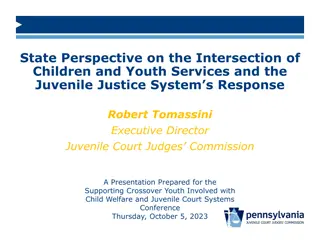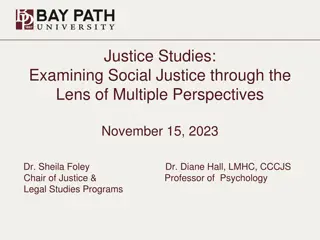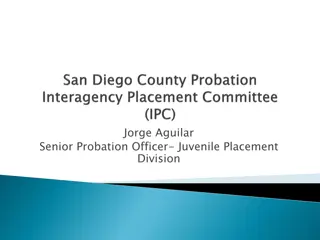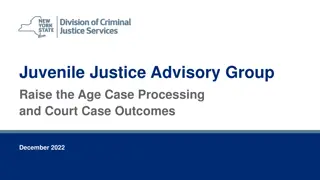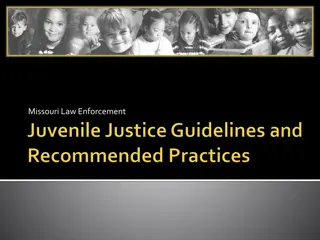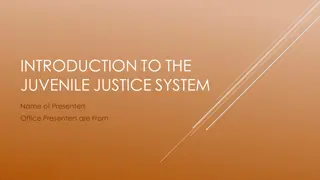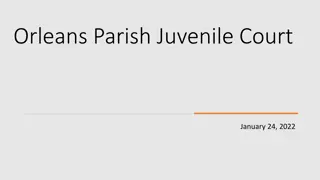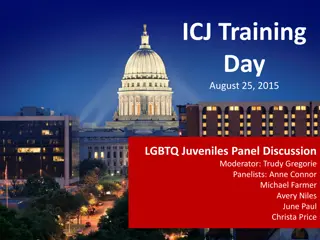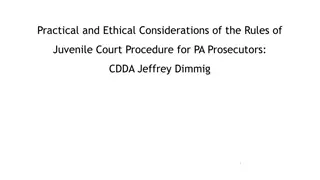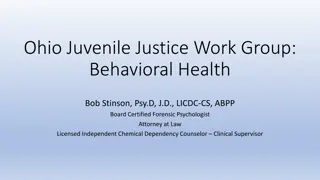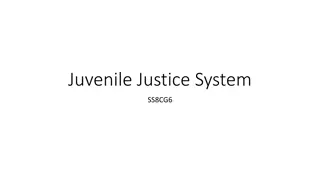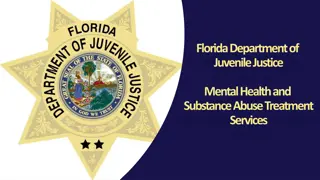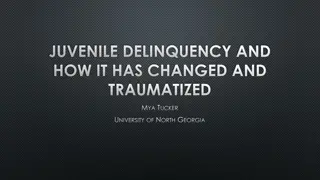Improving Youth Health and Resilience in Florida's Department of Juvenile Justice
This comprehensive presentation delves into the efforts of Florida's Department of Juvenile Justice, particularly the Office of Health Services, in enhancing the well-being and resilience of youth under their care. Dr. Rita Smith, the Chief Medical Officer, leads initiatives to strengthen resiliency through promoting healthy youth practices. The content explores the definition of a healthy youth, factors influencing their health, and the tools utilized to assess and improve their well-being. Additionally, it highlights the organization's vision and mission to create safe, nurturing environments for Florida's youth. The discussion extends to community assessment tools, such as the Community Assessment Tool (CAT), utilized to evaluate the health status of DJJ youth and implement evidence-based interventions to address risk factors associated with offending. Overall, the focus remains on enhancing the overall health and resilience of youth in Florida's juvenile justice system.
Download Presentation

Please find below an Image/Link to download the presentation.
The content on the website is provided AS IS for your information and personal use only. It may not be sold, licensed, or shared on other websites without obtaining consent from the author. Download presentation by click this link. If you encounter any issues during the download, it is possible that the publisher has removed the file from their server.
E N D
Presentation Transcript
Florida Department of Juvenile Justice Office of Health Services Strengthening Resiliency through Healthy Youth Dr. Rita Smith, DNP, MPH, APRN Chief Medical Officer Office of Health Services
Objectives Discussion of health as it relates to youth. Explore the general health of DJJ youth. Examine the role and impact of DJJ Office of Health Services on youth resiliency. Increasing and improving tools of health resiliency for DJJ youth.
What is the definition of a healthy youth?
What are the factors that impact the health and wellbeing of youth? Healthcare Access and Quality Education Access and Quality Social and Community Context Economic Stability Neighborhood and Built Environment Places where people live, learn, work, and play affect a wide range of health risks and outcomes.
Department of Juvenile Justice DJJ Vision: The children and families of Florida will live in safe, nurturing communities that provide for their needs, recognize their strengths and support their success. DJJ Mission: To increase public safety by reducing juvenile delinquency through effective prevention, intervention and treatment services that strengthen families and turn around the lives of troubled youth. DJJ strides to provide the best support for optimal health and wellbeing for youth in our custody and care.
How healthy are DJJ youth? Community Assessment Tool (CAT) DJJ used a tool (PACT) between 2006 to 2019 that was adapted from the Washington Institute for Public Policy risk-needs assessment that was validated and adapted widely for decades. Took the Big Eight risk factors that are associated with offending and re- offending, per criminology research and created 12 Domains. In 2019, PACT was replaced with the CAT, which captures the same risk/needs domains but has updated scoring based on FSU s analysis of real PACT data and recidivism data. Various evidence-based curricula, used mostly in Residential, targets one or more of these risk factors.
Big 8 vs. Community Assessment Tool (CAT)
Health Snapshot of Delinquent Youth Physical Health In 2022: surgical procedures: valve replacement, fractures hospitalizations: renal failure from Substance Abuse (SA), MRSA complex: DM Type I, seizure disorders, cardiac disorder from SA, asthma, hypertension, sickle cell disease, morbid obesity, underweight, fractures, sports injuries, pregnancy, gun shot wounds Residential programs can provide 24-hour nursing care to meet the needs of the youth.
Health Snapshot of Delinquent Youth Mental Health Among Residential youth, 22% have been in out-of-home DCF placement, 9% have received in-home services, and 41% have been the subject of an investigation. oThe numbers are higher for girls; only 7% have no history of investigation or services. Research in various jurisdictions using various methods over many years has consistently found extraordinarily high rates of trauma and other adverse childhood experiences among delinquent youth.
Health Snapshot of Delinquent Youth Adverse Childhood Experiences and Trauma oUp to 90% report exposure to traumatic events. o70% meet criteria for a mental health disorder. o30% - 50% meet criteria for PTSD. oOne study found that 29% of girls in residential care had a history of rape or molestation. oMany youth have experienced multiple traumatic events, often for prolonged periods of time.
Health Snapshot of Delinquent Youth NCTSN: https://www.tandfonline.com/doi/pdf/10.3402/ejpt.v4i0.20274?needAccess=true
Health Snapshot of Delinquent Youth Chronic trauma can lead to complex trauma, a severe disorder that can lead to a range of problems including but not limited to: Attachment: isolation, distrust, boundary problems, difficulties with empathy Biology: Sensorimotor development problems, range of medical problems Affect Regulation: Self-regulation problems, difficulties communicating feelings Behavioral Control: Poor impulse control, aggression, substance abuse, oppositional behavior, re-enactment of trauma, self-destructive behaviors Cognition: Learning problems, problems understanding own contribution to what happens to them, difficulties planning and anticipating Self-Concept: Lack of continuous, predictable sense of self, shame and guilt
Health Snapshot of Delinquent Youth Traumatic Brain Injury Histories (TBI): Various studies have found rates of around 30% among juvenile offender populations, with most injuries occurring prior to initiation of offending. TBI is associated with increased anger, aggression, depression, impaired judgment, agitation, substance abuse, and poor impulse control, all of which can increase likelihood of offending as well as impact behavior during incarceration and ability to reintegrate into the community.
Where are DJJ Youth? Self-actualization includes morality, creativity, spontaneity, problem solving, lack of prejudice, acceptance of facts.
How do we strengthen resiliency in DJJ youth? Oxford Dictionary: Resilience the capacity to recover quickly from difficulties; toughness For DJJ youth, this is a complex issue that requires a multifaceted approach from all programs.
Office of Health Services (OHS) History Established by statue February 21, 2005. Created following an incident that brought attention to the department for the need of oversight for medical and mental health services. Medical and mental health services are delivered by contracted providers to detention facilities and residential programs. Oversight and support to detention facilities and residential programs, support only for probation and prevention programs. OHS touches every area at DJJ.
OHS Vision and Mission Vison: The youth of Florida DJJ will be the healthiest in the nation. Mission: To ensure that the Department and our stakeholders provide professional, high quality, comprehensive and timely healthcare, mental health, substance abuse, and developmental disability services to our children.
OHS Overarching Goals Systemwide approach to excellence Improve the quality of services Expand resources Preeminent staffing Increase contract monitoring and standardization Superior technical assistance and training Early intervention of problem areas/programs Collaborations with other state agencies, i.e., Department of Children and Families, Department of Health, the Agency for Health Care Administration, and the Agency for Persons with Disabilities.
OHS Role in Resiliency Oversight & Monitoring Medical Services Dental Medical Vision Medically Complex Youth
OHS Role in Resiliency Oversight & Monitoring Mental Health Services Screening, assessment, evaluation, individual therapy, group therapy, family therapy, crisis intervention, suicide prevention and supportive services are offered at various levels of care. Individualized treatment based on needs of the youth including substance abuse and psychiatric services. Trauma Informed Care. Suicide Prevention.
Additional Roles of OHS Ensure best practices are implemented as well as scope of practice and contract adherence within detention facilities and residential programs. Clinical technical assistance and training to the contracted medical and mental health service providers. Consultation and support to Monitoring & Quality Improvement (MQI) field staff. Department s subject matter experts for clinical services in the field and headquarters. Participation in contract development and procurement of health services. Assists other bureaus such as Legal Affairs, General Counsel, Staff Development & Training with various activities.
Florida DJJ: National Best Practice Trauma Informed Care Suicide Prevention
Trauma Informed Care (TIC) Definition: Staff approach every encounter with the assumption that the youth has a trauma history and will adjust their interactions according to the individual child s needs. Over a decade ago, the OHS led the development of a statewide Trauma Informed Care (TIC) training. Face-to-face trainings were provided throughout the state of Florida to include direct care staff, headquarters staff, clinical staff, and administrative staff. As pioneers of TIC in the national juvenile justice field, a webinar training was provided to thousands of individuals internationally. The Department has interwoven TIC into every aspect of caring for the youth we serve. All new hires are required to complete TIC training.
Suicide Prevention Extensive Screening: Youth are identified as at risk for suicide through a myriad of screenings ( MAYSI-2 and SRSI) at various points of contact with the Department beginning at their arrest until they are released from the program. If, at any point, during the screening process a youth is identified as at risk for suicide the youth is immediately placed on suicide precautions. Assessment: Youth identified as at risk at screening or during length of stay receive an Assessment of Suicide Risk (ASR) by mental health professionals immediately or within 24 hours based upon the individualized needs of the youth. Daily Mental Health Contact: While a youth is placed on suicide precautions, they are provided with daily mental health treatment services who assess the youth daily with the Follow-up ASR. Juvenile Justice Information System (JJIS) Alerts: Once a youth is identified at risk for suicide, a suicide alert is entered into JJIS. This system houses treatment, placement and dispositional information.
Suicide Prevention cont. Baker Act: Youth who present an imminent threat of suicide must be treated as an emergency and the Baker Act is initiated. Suicide Drills: OHS sends out suicide mock drill scenarios to all detention facilities monthly for quarterly drills. Transitional Services: If a youth is at risk of suicide upon release from DJJ, the parents/guardian is provided with a written notification form with referral information. OHS Monitoring: Critical for constant quality improvement and ensuring the safety of the youth that are served. New Employee and Annual Training: These are required before contact with youth and annually for direct care staff.
OHS Projects to Strengthen Resiliency Complete development of EHR and implement statewide for seamless transition of services throughout the DJJ program areas and expand collaborative efforts with the DCF care for dually served youth. Establish data collection systems approach. Evidence-based innovations for telehealth. Increase technical assistance and support to compensate for high provider staff turnover. Optimization and stewardship of resources (e.g., ED utilization). Increased utilization of Mobile Response Teams for mental health crisis.
OHS Projects to Strengthen Resiliency cont. Investigate current, evidence based medical treatment for substance abuse. Collaboration with Department of Health for nutrition education grant. Communicate and gather nationally recognized evidence-based best practices for youth. Continued collaboration with DJJ Office of Prevention to strengthen community connection on improving factors that impact health and decreased disparities. Improve transition resources. Begin suicide mock drills with residential programs.
Questions? Florida Department of Juvenile Justice Office of Health Services (OHS) Restoring Hope October 2022





